-
Read more ...
Framing a photo with a mat puts a clear focus on the image. In combination with the right frame, you can create a real eye-catcher with your photo or artwork. In some cases, using a mat is not a question of aesthetics but pure necessity because the glass cannot get in direct contact with the art. This is for example true for pastel or charcoal drawings. If you were to frame such art pieces without a mat, the glass could cause damage to them. Using a thick cardboard mat separates the artwork and the glass. An additional advantage is that a mat regulates the moisture with the framing by absorbing it and this protecting the art piece.
Which tape to use?
To fix an art piece correctly behind the mat, you can use self-adhesive tapes. These tapes make sure that the picture stays neatly put behind the mat. The choice of tape depends on the artwork or photo to be framed. The weight and material of the piece determine which tape is suited best.
Regardless of which tape you choose, it is good to know that the following tapes have all passed the Photographic Activity Test (PAS) according to ISO 18916. They are, therefore, safe to use in combination with your artwork and photos, and will not negatively affect them over time.
Filmoplast P
Filmoplast P is used to mount art prints and reproductions of very thin paper to a matt. The practical dispenser packaging, featuring a cutting knife, makes it very easy to handle. The adhesive does not need to be moistened. With its calcium carbonate-buffered adhesive, Filmoplast P offers a slightly alkaline environment, which provides excellent absorption of the acids released from the paper and thus prevents damage. Thanks to its very thin carrier material, Filmoplast P is almost invisible after application. The thin and transparent paper is best suited for smaller pieces of art.
Filmoplast P90
Filmoplast P90 is made of tear-resistant special paper and is therefore used to fix heavier artworks (art prints, reproductions or originals) to a mat. There is no need to moisten the adhesive. Just like Filmoplast P, Filmoplast P90 is not only acid-free, but also slightly alkaline to adapt to the aging process of paper.
Filmoplast P90 plus
Thanks to its extra adhesive strength and strong tear-resistant, Filmoplast P90 plus is excellent for attaching heavier images, photos and prints to a mat or backing board and is also suited for dust-free sealing of backing boards. Just like its predecessors, Filmoplast P90 plus is acid-free, white and tear-resistant.
Matting a picture frame in 5 simple steps
Now that the choice of tape has been made, the mounting of the image behind the mat can begin.
- Apply the Filmoplast tape approx 2.5cm away from the edge and with 0.5cm overlapping the top edge of the artwork or photo to be mounted. This is done on both the top left and top right edge.
- Turn the medium so that the adhesive side of the tape points upwards.
- Place the medium in the middle onto the backing board behind the window of the mat and press firmly.
- Open the mat again and secure it with another strip of Filmoplast P, P90 or P90 plus over the existing strip on the backing board. This will create a so-called T-hinge.
- Press the two T-hinges firmly. The image is now attached behind the mat.


Applying the mat on the backing board
Filmoplast SH is used to create the so-called "hinge. The hinge refers to the connection of the backing board and the mat, which is created by a particularly flexible and elastic tape. Filmoplast SH is made of a textile fabric and, therefore, very tear-resistant. Additionally, it is acid- free and environmentally friendly because it is biodegradable. The coated adhesive is free of solvents, acids and phthalates and is resistant to ageing, does not yellow and is permanently elastic.
- Place the mat's top edge against the top edge of the backing board. Leave a gap of approx. 1 mm between the mat and the backing board.
- Attach the two materials to the opening with a strip of Filmoplast SH or Filmoplast P 90 plus to create the hinge. Note: the adhesive strip should be approx. 4 cm shorter than the mat.
For light to medium weight materials, we recommend the use of Filmoplast P 90 plus. For particularly heavy and thick materials (e.g. a double mat), we recommend Filmoplast SH.
Sealing the frame with Filmoplast T
As a finishing touch, Filmoplast T is used for dust-proof sealing on the back of the frame, protecting the artwork from dirt and dust.
-
Read more ...
Protecting what is valuable: Neschen is regarded as the inventor of self-adhesive products for the professional repair and protection of books and documents. We are proud to say that these products are often taken off the shelf or are regularly, eventually take damage. These damages can range from torn or loose pages to damaged book spines. Replacing books can create high additional costs for libraries. Since prevention is always better than repairing the damage, it is a wise decision to protect or strengthen books and papers. This increases durability and saves costs.
Protecting history | Preservation of Documents
Besides being used for books, our products are used to repair and protect important documents. Many of the Filmoplast® line of products have a special composition that works perfectly with the chemical composition of aged paper and the ageing resistance of several products has been assessed and certified by the Foundation for Paper Technology (PTS) in Munich
Filmoplast® R for example is used in the Political Archive of the Federal Foreign Office in Berlin. The Political Archive is almost like a "memory" of the German Foreign Service. Twentyseven kilometers of shelves containing diplomatic documents since 1871, including 35,000 international treaties and countless personnel records bear witness to history. The material is accessible to everyone within the framework of the legal provisions. In the public reading room with 32 sears, more than 1,000 visitors per year inform themselves about historical contexts.
The archive also holds its own restoration workshop, in which employees process damaged archive materials. These include 75 meters of shelf space for fire-damaged files from World War II. The experts bring the archive records into a condition that protects them from further decay for as long as possible and that allows them to be worked with.
Important historical documents, which were partially damaged by fire during World War II, have been sealed with Filmoplast R to preserve them from further damage. Since the mid 1990s, the staff of the restoration workshop have been using Neschen Filmoplast® R for their work.
Filmoplast® R is a wafer-thin, transparent, technical Japanese paper for mass conservation. It is also an ideal material for the preservation of modern papers and newspapers (for wood pulp papers, approx. from the middle of the 19th century). Woodpulp papers contain acid (lignin), which attacks the paper from the inside. This valuable documentation of our past will destroy itself. When encapsulated in Filmoplast® R the magnesium carbonate in the adhesive neutralizes acids and prevents migration through the adhesive layer into the Filmoplast R paper layer, thus stabilizing the encapsulated document. Due to the low thickness of the material Filmoplast® R is hardly visible. The paper character of the original is preserved. Encapsulated book pages can easily be put together again as a book.
Skip to Content
- Create an Account
- Offers for you

+44 (0) 1527 853 136







